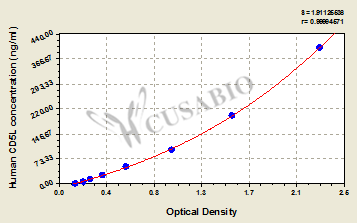The product CSB-E13423h is a sandwich ELISA kit developed to measure concentrations of human CD5L in serum, plasma, or tissue homogenates. This assay uses the sandwich enzyme immunoassay technique in combination with the enzyme-substrate chromogenic reaction to quantify the analyte in the sample. The color develops positively to the amount of CD5L in samples. The color intensity is measured at 450 nm via a microplate reader.
CD5L is a secreted protein produced mostly by macrophages in lymphoid and inflamed tissues. It plays a critical role in immune homeostasis and inflammatory disease. It is involved in various diseases such as lipid metabolic disease, hepatocellular carcinoma, fungus-induced peritonitis, acute kidney injury, and myocardial infarction. CD5L localizes to CD36 to promote the transcription of genes involved in the regulation of mitochondrial biogenesis to maintain energy and metabolic homeostasis. CD5L also activates autophagy in macrophages while altering inflammatory phenotypes, specifically reducing TNF and IL-1 beta expression while elevating the immunosuppressive cytokine IL-10. Serum or plasma CD5L levels are increased in inflammatory conditions including liver cirrhosis, chronic hepatitis C, atopic dermatitis, and Kawasaki disease.






